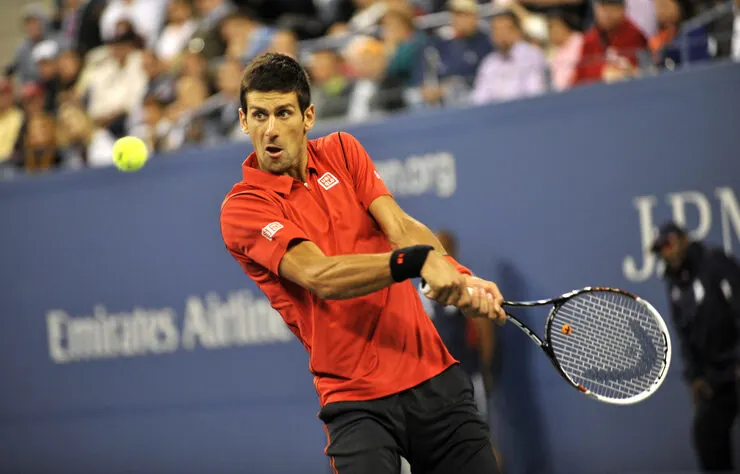
There are numerous tennis racquet choices when it comes to shopping around and purchasing a new weapon of choice. Whether it’s considering brand, head size, grip size, or the strings that go into the racquet, there’s a lot to consider. It can almost be overwhelming for the average player.
The string pattern is one more thing players must consider before buying a new racquet.
While various string patterns exist, the two most common string patterns in the tennis game today are 16×19 and 18×20. Understanding the differences between the two can help a person decide which option is best for them.
How to Read a String Pattern
Reading a string pattern is simple enough on any tennis racquet. Count the number of strings running vertically and horizontally, and that is the string pattern.
The main strings, also known as just mains, run vertically from the end of the frame to the throat. In a simple string pattern reading, the main strings always get mentioned first.
The second number is the horizontal cross strings. The shortened name for them is crosses. It’s an easy way to judge a racquet just by understanding the string pattern. Spit out a few numbers in shorthand, and tennis players automatically know what they refer to.
16×19 String Pattern – Pros & Cons

Leaning towards a 16×19 string pattern? While it’s always best to try out each racquet, these are the pros and cons of a 16×19 string pattern.
Pros
A standard 16×19 string pattern almost always lays out as an open string pattern. The squares that the mains and crosses create are larger, which provides the advantage of hitting with more power.
Since the ball is making contact with fewer strings at a time, the ball can launch off of the racquet easier. The ball digs into the racquet a bit more, allowing the strings to dictate ball movement and speed.
A 16×19 string pattern also allows for better spin potential and depth on shots. Players who struggle with power and spin can see an increase right away with a 16×19 string pattern. The type of string can further make an impact.
Cons
Players sacrifice control when they are using 16×19 string patterns. Not only that, but it’s easier to snap a string since there’s more movement. Durability takes a hit compared to an 18×20 setup.
There’s a bit more of a learning curve jumping from an 18×20 to a 16×19, so keep that in mind as well. Balls could initially jump off the racquet and seem uncontrollable at first. It takes a little bit of time to start dialing in shots and have them go to the right spots.
18×20 String Pattern – Pros & Cons

Is an 18×20 string pattern seeming more likely? A dense string pattern like this can help certain players. Even professionals use this setup and have outstanding success.
Pros
A dense string pattern benefits flat hitters quite a bit. They will notice that they have great control of shots hit anywhere on the court. Since the ball makes contact with more strings and time, it has great potential to go exactly where a person wants it to go.
Power and spin are still available on an 18×20 string pattern. Players can tinker with string setup for additional power and spin if they feel it’s lacking.
Serial string breakers might fall in love with the 18×20 string pattern so they aren’t going through as many strings. Less movement usually means fewer breaks.
Cons
An 18×20 string pattern, simply put, will feel just a bit more dead than a 16×19. Players will notice a decrease in free power, less spin potential, and a racquet that feels more solid overall. Not everyone loves that feeling on the tennis court.
What Else Dictates How a Racquet Plays?
After picking between a 16×19 or 18×20 string pattern, there are still ways to tinker with how a racquet plays. The string can change so many different aspects for the average player.
To start, try out different types of strings. Modern players might gravitate more towards polyester, while others will want a softer natural cut or multifilament. There are different gauges for all types of string, with thicker gauges being more durable by providing a little less feel.
Tension will also play a huge role in how a racquet plays. For more power and spin, dropping the tension is a way to go. At the professional level, some players string in the 30-35 pound range, while others will double that.
How to Make a Proper Choice
The best thing to do to choose string patterns is to try out the different options that are out there. It’s the only way to truly get a feel and see how much of a difference it makes for certain playstyles.
Keep in mind that string patterns will still be different from model to model. For example, a 16×19 string pattern can be a bit more closed if the strings are close together in the middle of the racquet. Some companies will do this to offer more control. How the weight is distributed on the racquet can also factor in.
Most tennis companies will offer a wide range of demo racquets for players to mess around with before purchasing. It’s worth taking a little bit of extra time to look at all the different options instead of just settling.
Too many people get themselves in trouble with picking whatever seems to stand out at first. Then they want to change racquets a few weeks or months later.
Why String Pattern Matters
Having two extra mains and one extra cross string might not seem like much, but a tennis racquet can play much differently with a subtle change. Even if everything else on the two racquets is similar, a string pattern change will make an impact.
Keep in mind that these aren’t the only two patterns out there. There are lesser-known patterns like 16×20 or 18×19 to give a try. All of them play a little bit differently, and the head size can dictate the string pattern as well.
All in all, every player should feel confident in the racquet that they ultimately pick. Using string pattern advantages can take a player’s game to the next level. It takes some getting used to just like everything else, but players who make a smart change for the better usually end up liking the move.
